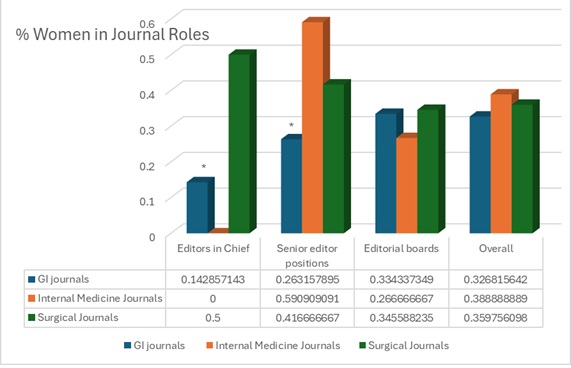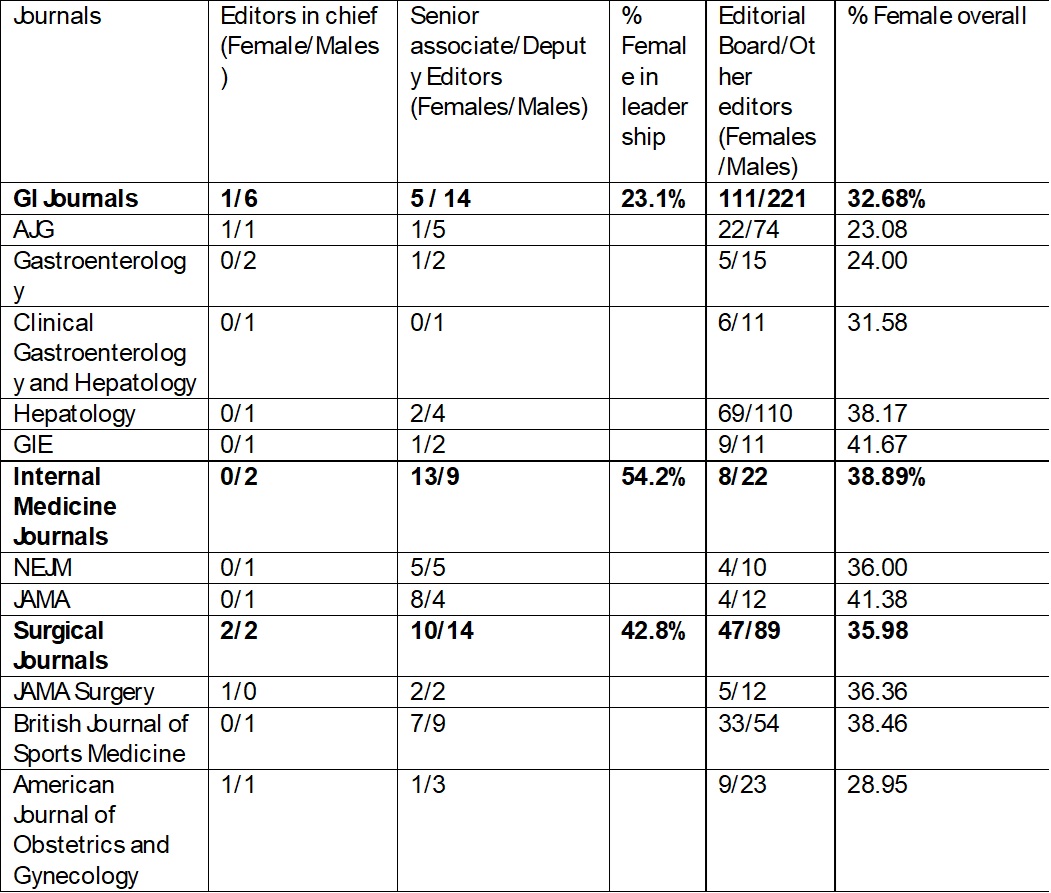Tuesday Poster Session
Category: Practice Management
P6194 - Female Participation in Editorial Boards of Gastroenterology, Internal Medicine, and Surgery Journals
Tuesday, October 28, 2025
10:30 AM - 4:00 PM PDT
Location: Exhibit Hall

Anisha Nachnani
University School of Nashville
Nashville, TN
Presenting Author(s)
Anisha Nachnani, 1, Xiao Jing Wang, MD2
1University School of Nashville, Nashville, TN; 2Mayo Clinic, Rochester, MN
Introduction: Female representation is increasing across medical fields with approximately 21% of practicing GI as women. Editorial boards shape priorities in research, influence publication records, and strongly influence the career advancement of academic physicians and trainees. We aimed to evaluate the balance of male and female representation in top tier publications in the field of gastroenterology (GI) and compare this to general medicine and surgical fields where female representation ranges from 40% of internal medicine, 24% of general surgery, 6% orthopedics, and 85.2% in Ob/Gyn. We focused on specific leadership roles including Editor-in-Chief, Deputy Editor, and Senior Associate Editor, as well as the editorial board to assess gender representation in top medical publishing.
Methods: Data was gathered from the website of journals with the highest impact factor across subspecialties and editors were sorted into categories based on their titles—Editor-in-Chief, Deputy Editor, Senior Associate Editor, Associate Editor, and editorial board. Percentages of females in each category was assessed and compared across specialty journals using nonparametric testing.
Results: We found that most gastroenterology (GI) journals had more male editors than female editors, especially in leadership roles (Table 1). Among top GI journals, 16.67% (1/6) of editors in chief and 26.32% (5/19) of the senior editorial teams were women. Editorial boards were balanced with 50.2% women.
In top internal medicine journals, 0/2 editors in chief and 59% (13/22) of other editorial leadership positions were women. Among the surgical journals, 50% (2/4) of editors in chief and 41.7% (10/24) of senior editors were women.
In analysis, there is a significant difference between representation at the level of editors in chief (p< 0.001), senior editor positions (p=0.01), but not at the level of the editorial board (p=0.62) or overall (p=0.83).
Discussion: Despite increasing numbers of women in gastroenterology, men still hold most of the top editorial jobs in gastroenterology journals. Internal medicine journals and surgical journals both have higher percentages of women in senior editor positions. At the level of the editorial board, representation is more balanced and does not differ between specialties. Intentionality in selection of editorial board members can help improve this balance in the Gastroenterology field.

Figure: Table 1: Female Participation in Journal Leadership

Figure: Graph 1: Percent Female participation in Journals by subspecialty
Disclosures:
Anisha Nachnani indicated no relevant financial relationships.
Xiao Jing Wang indicated no relevant financial relationships.
Anisha Nachnani, 1, Xiao Jing Wang, MD2. P6194 - Female Participation in Editorial Boards of Gastroenterology, Internal Medicine, and Surgery Journals, ACG 2025 Annual Scientific Meeting Abstracts. Phoenix, AZ: American College of Gastroenterology.
1University School of Nashville, Nashville, TN; 2Mayo Clinic, Rochester, MN
Introduction: Female representation is increasing across medical fields with approximately 21% of practicing GI as women. Editorial boards shape priorities in research, influence publication records, and strongly influence the career advancement of academic physicians and trainees. We aimed to evaluate the balance of male and female representation in top tier publications in the field of gastroenterology (GI) and compare this to general medicine and surgical fields where female representation ranges from 40% of internal medicine, 24% of general surgery, 6% orthopedics, and 85.2% in Ob/Gyn. We focused on specific leadership roles including Editor-in-Chief, Deputy Editor, and Senior Associate Editor, as well as the editorial board to assess gender representation in top medical publishing.
Methods: Data was gathered from the website of journals with the highest impact factor across subspecialties and editors were sorted into categories based on their titles—Editor-in-Chief, Deputy Editor, Senior Associate Editor, Associate Editor, and editorial board. Percentages of females in each category was assessed and compared across specialty journals using nonparametric testing.
Results: We found that most gastroenterology (GI) journals had more male editors than female editors, especially in leadership roles (Table 1). Among top GI journals, 16.67% (1/6) of editors in chief and 26.32% (5/19) of the senior editorial teams were women. Editorial boards were balanced with 50.2% women.
In top internal medicine journals, 0/2 editors in chief and 59% (13/22) of other editorial leadership positions were women. Among the surgical journals, 50% (2/4) of editors in chief and 41.7% (10/24) of senior editors were women.
In analysis, there is a significant difference between representation at the level of editors in chief (p< 0.001), senior editor positions (p=0.01), but not at the level of the editorial board (p=0.62) or overall (p=0.83).
Discussion: Despite increasing numbers of women in gastroenterology, men still hold most of the top editorial jobs in gastroenterology journals. Internal medicine journals and surgical journals both have higher percentages of women in senior editor positions. At the level of the editorial board, representation is more balanced and does not differ between specialties. Intentionality in selection of editorial board members can help improve this balance in the Gastroenterology field.

Figure: Table 1: Female Participation in Journal Leadership

Figure: Graph 1: Percent Female participation in Journals by subspecialty
Disclosures:
Anisha Nachnani indicated no relevant financial relationships.
Xiao Jing Wang indicated no relevant financial relationships.
Anisha Nachnani, 1, Xiao Jing Wang, MD2. P6194 - Female Participation in Editorial Boards of Gastroenterology, Internal Medicine, and Surgery Journals, ACG 2025 Annual Scientific Meeting Abstracts. Phoenix, AZ: American College of Gastroenterology.

